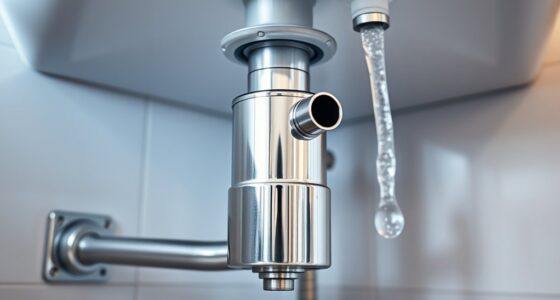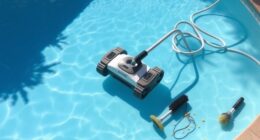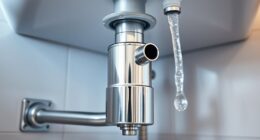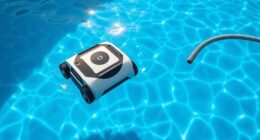Suction pool cleaners work by connecting to your pool’s filtration system, which creates water flow and suction. The pump pulls water, debris, and dirt into the cleaner’s hose and filters, while brushes scrub the pool floor and walls. Movement is guided by wheels, rollers, or magnets, helping the cleaner navigate the surface efficiently. Factors like water pressure and filter cleanliness impact performance. Keep exploring to discover how to keep your cleaner running smoothly.
Key Takeaways
- A pump creates suction by drawing water, debris, and air into the cleaner body through hoses.
- The cleaner uses brushes and rollers to scrub pool surfaces and loosen dirt and algae.
- Negative pressure inside the cleaner pulls debris into a filter basket or bag for collection.
- Movement patterns like rolling or magnetic guidance ensure thorough coverage of the pool area.
- Proper water circulation and chemical balance optimize suction, prevent clogs, and maintain efficient cleaning.
Components of a Suction Pool Cleaner

A suction pool cleaner consists of several key components that work together to keep your pool spotless. The main parts include a pump, hoses, and the cleaner itself. The pump creates suction, drawing water and debris into the device. Hoses connect the cleaner to the skimmer or dedicated suction port, guiding debris toward the filtration system. The cleaner’s brushes or pads scrub the pool floor and walls, loosening dirt and algae. While not directly involved in water chemistry, the cleaner’s performance depends on water temperature and pool chemical balance, which affect debris looseness and the cleaner’s movement. Maintaining proper water chemistry ensures ideal cleaning efficiency, preventing buildup that could clog components or hinder movement. Properly functioning components are essential for effective pool maintenance. Additionally, contrast ratio can influence the visibility of debris and dirt during cleaning, especially in varying lighting conditions around the pool area.
The Role of the Pool’s Filtration System

The pool’s filtration system plays a crucial role in maintaining clean and healthy water by trapping dirt, debris, and algae before they circulate throughout the pool. Its effectiveness depends on several factors:
- Filtering efficiency determines how well it captures tiny particles, ensuring clear water. A highly efficient filter reduces the load on the suction cleaner and minimizes maintenance needs. Regularly upgrading or maintaining the filter components can enhance filtering efficiency.
- Debris capacity influences how much debris the filter can hold before needing to be cleaned.
- Regular maintenance boosts both filtering efficiency and debris capacity, preventing clogs.
- A well-functioning system reduces strain on the suction cleaner, allowing it to operate smoothly. Properly selecting and configuring the filtration system based on bicycle tire longevity and pool size can improve overall performance.
- Incorporating advanced automation technologies can further optimize the filtration process and improve overall pool maintenance. An understanding of trust issues and the importance of proper system operation can help prevent problems that lead to breakdowns or inefficiencies.
How Suction Power Is Generated
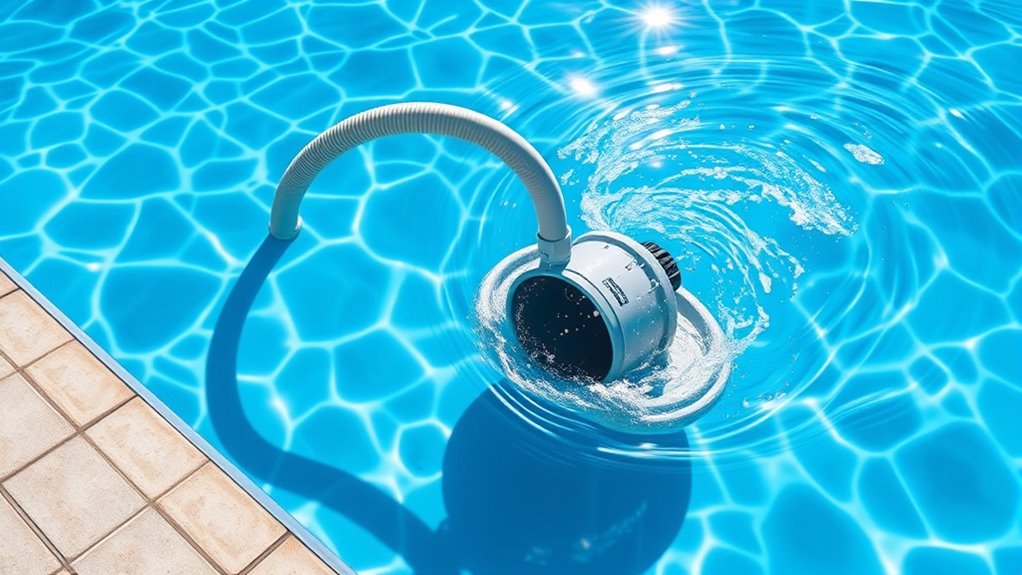
Suction power starts when the cleaner pumps water and air, creating negative pressure that pulls debris. The motor’s power and efficiency determine how strong and consistent this suction is. Understanding how these elements work together helps you choose the right pool cleaner for your needs. Additionally, Mazda Tuning techniques can influence the performance of various vehicle components, similar to how optimizing a pool cleaner’s motor can enhance its efficiency. Proper maintenance of the suction system ensures sustained performance and longevity of the cleaner. Regularly checking and maintaining the airflow around the unit can prevent blockages and improve overall suction effectiveness. Recognizing the role of vacuum pressure can further help optimize your cleaner’s operation and efficiency. Improving air filtration can also contribute to more consistent suction performance and better debris removal.
Pumping Air and Water
Ever wonder how a suction pool cleaner pulls debris from the water? It all comes down to pumping air and water to create the necessary suction. Here’s how it works:
- The pump draws in water, influenced by factors like water temperature, which affects water viscosity. Proper pump operation is essential for maintaining consistent suction power.
- As water flows, it passes through the filter, removing debris and particles.
- The pump’s motor creates airflow that helps maintain consistent pressure.
- Proper pool chemical balance ensures water flows smoothly, preventing clogging and maintaining ideal suction.
- Regular maintenance of the pump and filter system helps sustain optimal suction power for efficient cleaning. Additionally, understanding heat pump technology can provide insights into energy-efficient water circulation systems.
- Ensuring the filter system is clean and functioning properly is crucial for maintaining steady suction and preventing clogs that could reduce cleaning efficiency. Regularly checking for clogged filters can prevent pressure drops and improve performance. Proper water temperature and chemical levels also play a vital role in enhancing this process for better performance.
Creating Negative Pressure
Creating negative pressure is the key to generating the suction power that pulls debris into your pool cleaner. By lowering the water pressure inside the cleaner, a strong vacuum forms, drawing in dirt, leaves, and small particles. Factors like pool chemical levels and water temperature influence water flow and pressure consistency, affecting suction strength. To better understand, consider this table:
| Factor | Effect on Suction Power | How to Optimize |
|---|---|---|
| Pool chemical | Can cause buildup, reducing flow | Maintain proper chemical balance |
| Water temperature | Alters water viscosity, influencing flow | Keep water within ideal range |
| Pump pressure | Directly impacts suction strength | Regularly check and adjust |
| Filter cleanliness | Clogs decrease suction | Clean filters regularly |
| Hose integrity | Leaks weaken vacuum | Inspect and repair hoses |
This balance ensures your cleaner works efficiently, regardless of water conditions.
Motor Power and Efficiency
Motor power is the driving force behind your pool cleaner’s suction capabilities. It determines how effectively it removes debris and maintains cleanliness. To optimize motor efficiency, consider these factors:
- Motor Wattage: Higher wattage motors generate stronger suction, helping with stubborn debris. Regular maintenance of your motor can prevent energy loss and maintain optimal suction power.
- Water Temperature: Warmer water can improve motor performance but may also accelerate wear.
- Pool Chemical Balance: Proper chemical levels prevent corrosion, ensuring your motor runs smoothly and protects vital components.
- Design Efficiency: Advanced motor designs reduce energy consumption while maintaining strong suction. Maintaining optimal chemical balance can also protect your motor from corrosion and extend its lifespan.
A well-maintained motor uses less power and maximizes suction, especially in varying water conditions. Adjusting pool chemical levels and monitoring water temperature can prolong motor life and improve overall cleaning efficiency. Additionally, ensuring your pool’s automation systems are properly integrated can optimize overall cleaning performance and motor usage.
Movement Mechanisms of the Cleaner
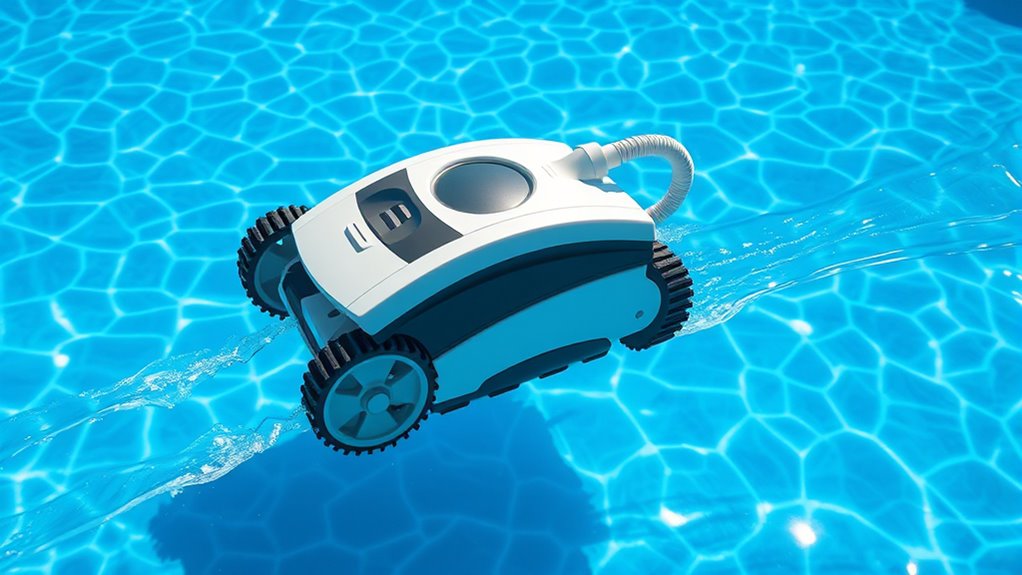
You’ll notice that many suction pool cleaners move using rolling motion patterns or magnetic track guidance. These mechanisms help the cleaner navigate efficiently across the pool’s surface. Understanding how they function can help you choose the most effective model for your pool. Additionally, some models incorporate cost behavior analysis to optimize their operation and efficiency. Recognizing the best performing models can further assist in selecting a reliable cleaner that meets your needs. Moreover, movement mechanisms can vary depending on design features and intended use, impacting cleaning performance and energy consumption.
Rolling Motion Patterns
Rolling motion patterns are essential for the effective movement of suction pool cleaners across the pool surface. They enable the cleaner to navigate efficiently, conserving energy and maintaining steady coverage. These patterns rely on robotic navigation to determine the most effective route. To optimize performance, the cleaner:
- Uses a combination of wheels and rollers to propel itself in smooth, controlled motions.
- Incorporates sensors to detect obstacles and adjust its path dynamically.
- Repeats specific patterns to ensure thorough cleaning without unnecessary energy expenditure.
- Maintains a consistent rolling rhythm that maximizes coverage while minimizing power use.
This movement mechanism ensures the cleaner moves fluidly over the surface, avoiding dead zones. The focus on energy efficiency helps prolong battery life and enhances overall cleaning performance.
Magnetic Track Guidance
Magnetic track guidance offers a precise and reliable way for suction pool cleaners to navigate complex pool layouts. This system uses magnets embedded in the cleaner and metal tracks installed along the pool walls, allowing the device to follow a predetermined path. The magnetic track guidance leverages surface adhesion, ensuring the cleaner stays firmly attached to the pool surface without slipping. As you program the cleaner’s route, it uses the magnetic attraction to stay aligned with the track, even around corners and obstacles. This method eliminates the need for sensors or random movement, providing consistent coverage. With surface adhesion and magnetic guidance working together, your pool cleaner moves smoothly and efficiently, thoroughly cleaning every corner without getting lost or stuck.
How Debris Is Collected and Stored
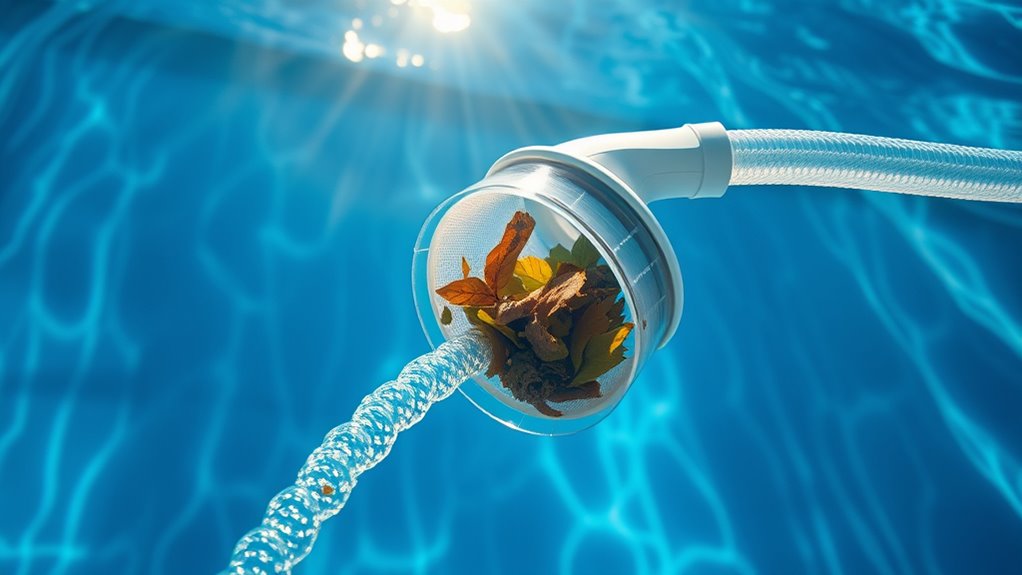
Suction pool cleaners collect debris through a powerful intake that pulls leaves, dirt, and other particles into an onboard or external container. To work effectively, your pool’s chemical balance and water circulation patterns are vital. Proper chemical levels ensure debris stays suspended and easier to remove. Water circulation directs debris toward the cleaner’s intake, enhancing efficiency.
Here’s how debris is stored:
- Debris enters the filter basket or bag via the intake port.
- Larger particles are trapped in the main container or skimmer basket.
- Finer dirt and dust are captured by finer filter elements.
- When full, the container or bag signals you to empty it, maintaining peak suction.
Maintaining balanced chemicals and good circulation ensures debris flows smoothly into the storage container, maximizing your cleaner’s performance.
The Importance of the Pool’s Skimmer and Returns
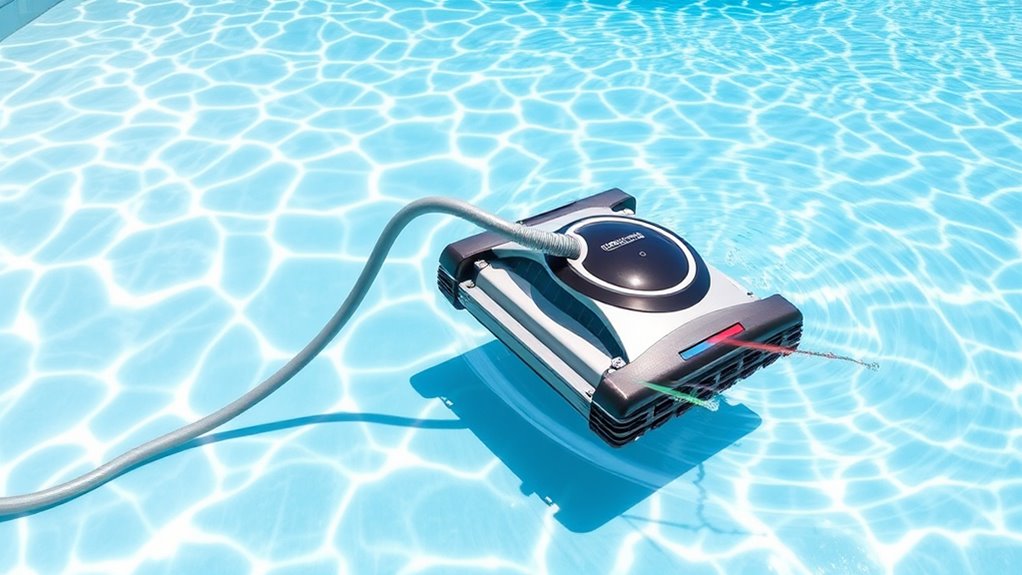
The pool’s skimmer and returns play a essential role in maintaining clean and balanced water. They help circulate water, ensuring debris is captured by the skimmer and evenly distributed through the pool. Proper circulation is necessary for maintaining ideal water temperature and preventing stagnant areas. When the water flows correctly, it supports the effective distribution of pool chemicals, keeping water sanitized and clear. The skimmer removes surface debris before it sinks, reducing strain on your suction pool cleaner. Meanwhile, the returns help mix chemicals and regulate water temperature, preventing cold spots or uneven heating. Together, they create a balanced environment that reduces algae growth and keeps your pool water inviting and safe. Properly functioning skimmers and returns are essential for effective pool maintenance and cleaner operation.
Types of Suction Pool Cleaners
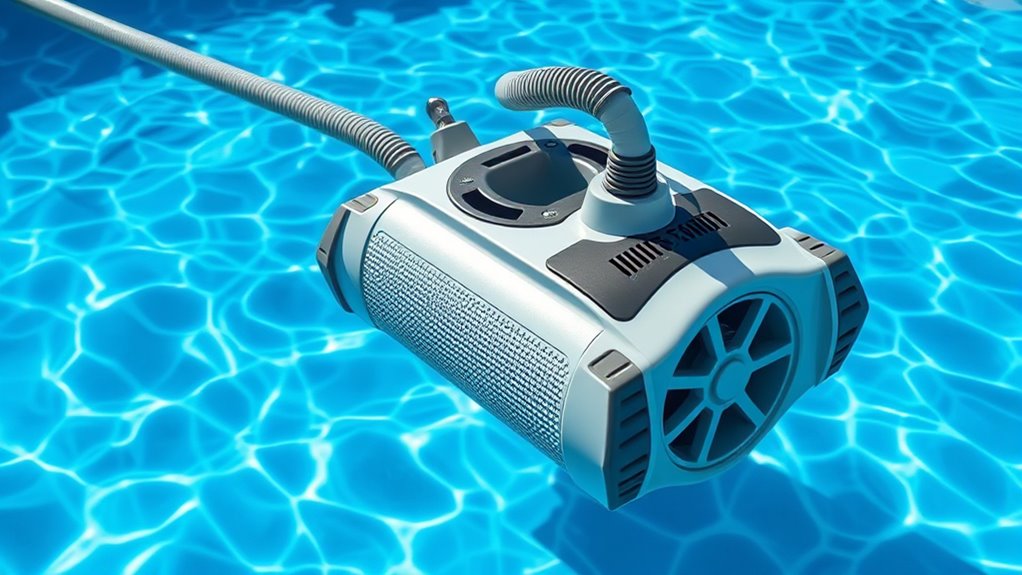
Different suction pool cleaners come with various features to fit your needs. Some climb walls easily, while others are manual or automatic. You’ll also find models designed specifically for in-ground or above-ground pools, making selection straightforward.
Wall Climbing Ability
Many suction pool cleaners are designed with wall climbing abilities that enable them to navigate vertical surfaces and reach difficult areas of your pool. This feature is especially useful when considering factors like pool chemistry and water temperature, which can affect adhesion and movement. To optimize their performance, look for models with these capabilities:
- Strong suction power to cling to walls effectively.
- Adjustable brushes or skirts that improve grip on slick surfaces.
- Sensors that detect vertical surfaces and adjust cleaning paths accordingly.
- Durable materials resistant to corrosion from varying pool chemistry and temperature fluctuations.
These features ensure your cleaner can climb walls reliably, providing thorough cleaning without missing spots, regardless of water conditions. Properly designed wall climbing cleaners give you peace of mind, knowing your entire pool gets cleaned efficiently.
Manual vs. Automatic
Choosing between manual and automatic suction pool cleaners depends on your pool’s size, shape, and your maintenance preferences. Manual operation requires you to guide the cleaner around the pool, giving you control over cleaning areas, but it’s more time-consuming. Automatic cleaners, often equipped with robotic navigation, independently move around the pool, efficiently covering surfaces without your input. If you prefer hands-on control or have a small pool, manual cleaners might suit you best. For larger pools or those seeking convenience, automatic options save time and effort. Robotic navigation helps automatic cleaners avoid obstacles and optimize coverage, making them more effective. Ultimately, your choice hinges on how much time you want to spend cleaning and the level of automation you prefer.
In-Ground vs. Above-Ground
In-ground suction pool cleaners are designed specifically for permanent pools installed below the ground level, offering a sleek and seamless look. They are ideal for maintaining pools with consistent water conditions, where monitoring pool chemicals and water temperature is essential. When choosing between in-ground and above-ground cleaners, consider these points:
- Installation – In-ground models require more complex setup but cover larger areas efficiently.
- Mobility – Above-ground cleaners are portable, perfect for pools that are seasonal or less permanent.
- Performance – In-ground cleaners often handle debris better in water temperature fluctuations, helping maintain water quality.
- Cost – Above-ground options are generally more affordable and easier to service, but may need more frequent cleaning due to debris accumulation.
Your choice depends on pool type, usage, and your maintenance preferences.
Installation and Setup Process
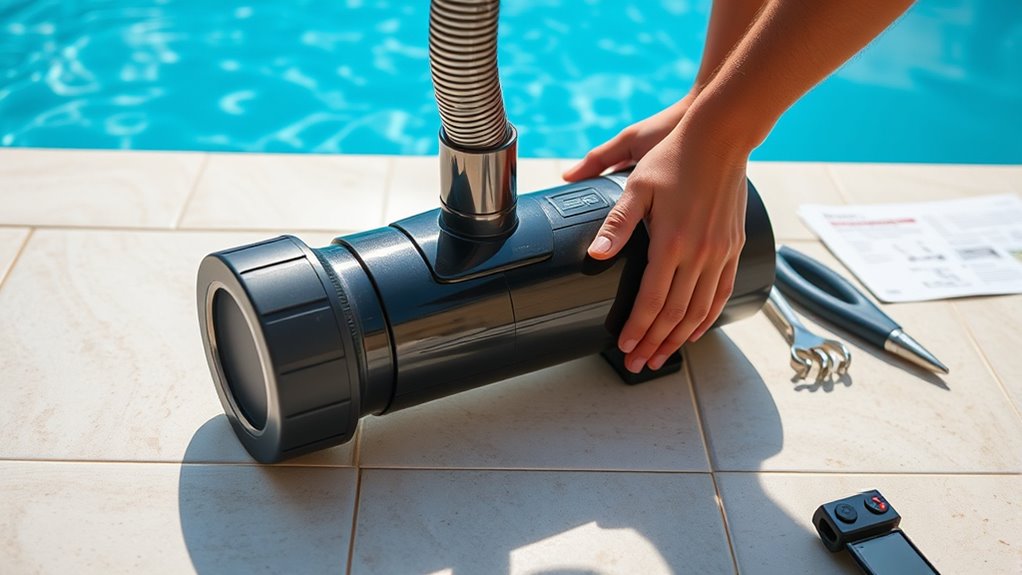
Setting up your suction pool cleaner is a straightforward process that guarantees peak performance. First, verify your pool’s chemical balance is proper, with the correct pH and chlorine levels, to protect the cleaner’s components. Next, check water circulation; good flow helps the cleaner move efficiently and avoid stagnation. Attach the hose to the cleaner and connect it to your skimmer or dedicated suction line, making sure all connections are secure. Place the cleaner in the pool, ensuring it can move freely without obstructions. Turn on the pool pump to start water circulation. Observe the cleaner’s movement for a few minutes to confirm proper operation. Regularly monitor water flow and chemical levels to maintain ideal cleaning performance over time.
Maintenance and Troubleshooting
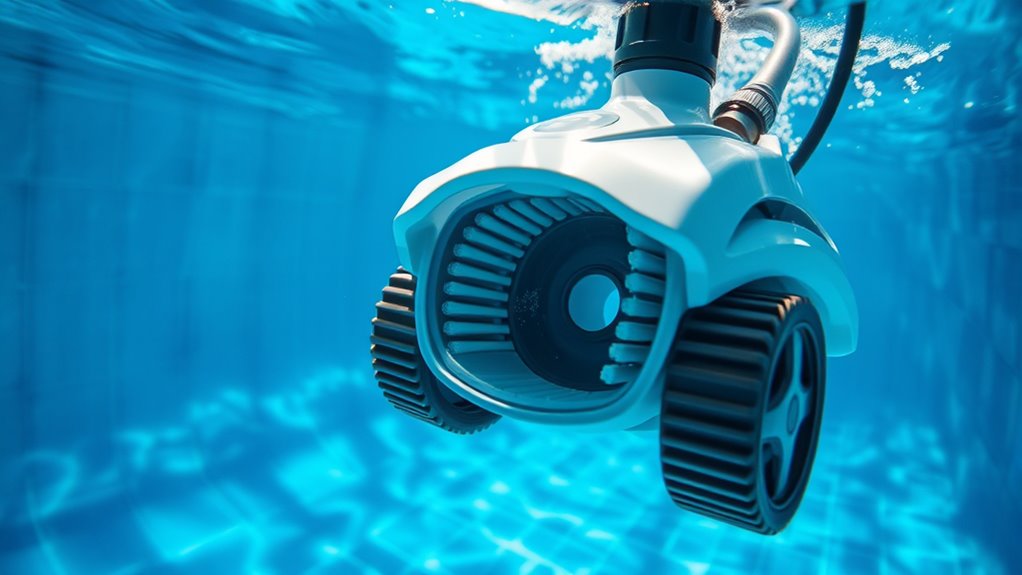
Regular maintenance and troubleshooting are essential to keep your suction pool cleaner operating effectively. Proper water chemistry ensures ideal performance and prevents issues. To maintain this, check your chemical balance regularly, especially pH and chlorine levels. When troubleshooting, consider these steps:
Regular maintenance and proper water chemistry keep your pool cleaner running smoothly.
- Inspect and clean the skimmer and filter baskets to prevent clogging.
- Check hoses and connections for leaks or obstructions.
- Test the water chemistry and adjust chemicals to maintain proper balance.
- Examine the cleaner’s brushes and wheels for wear, replacing if necessary.
Benefits of Using a Suction Pool Cleaner
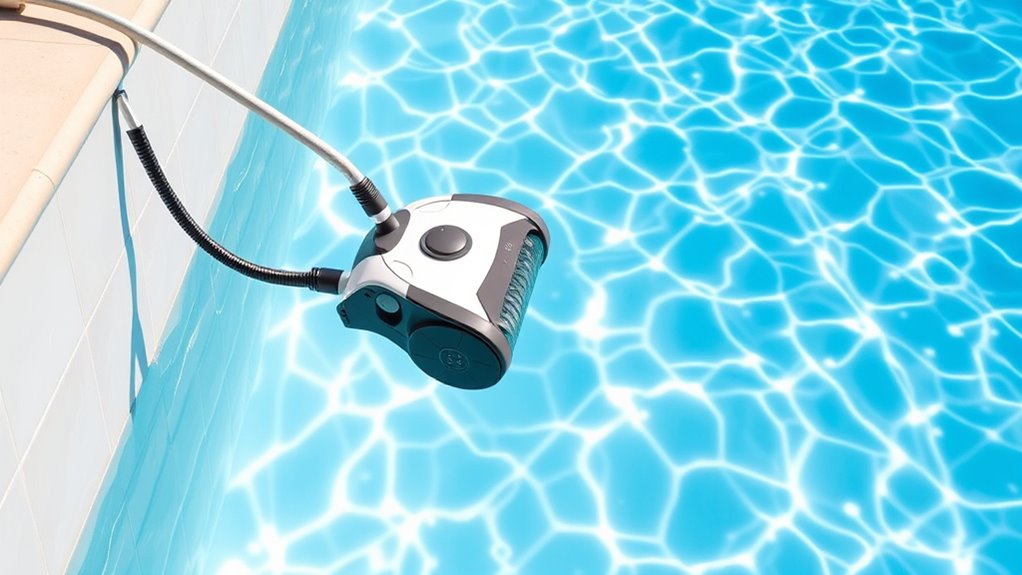
Using a suction pool cleaner offers several advantages that make maintaining your pool easier and more efficient. It helps keep your water clean by effectively removing dirt, debris, and algae, reducing the need for frequent manual cleaning. This cleaner promotes proper chemical balancing by preventing debris buildup that can disrupt water chemistry. Additionally, a cleaner pool improves overall aesthetics, making pool lighting more noticeable and enhancing your swimming experience. You’ll spend less time scrubbing and more time enjoying your pool. Suction cleaners are energy-efficient and easy to operate, saving you money and effort. Plus, their consistent cleaning guarantees your pool remains inviting and safe, with fewer issues related to debris accumulation or poor water quality.
Frequently Asked Questions
Can Suction Pool Cleaners Clean All Pool Surfaces Effectively?
Suction pool cleaners can effectively clean most pool surfaces, but their cleaning efficiency varies based on pool surface compatibility. They work well on smooth surfaces like vinyl and concrete, but may struggle with textured or pebble finishes. To get the best results, choose a cleaner suited to your pool’s surface, and regularly check its operation. Proper maintenance guarantees consistent cleaning, keeping your pool spotless and well-maintained.
How Long Does It Typically Take for a Suction Cleaner to Clean a Pool?
Cleaning your pool with a suction cleaner is like watching a busy bee at work. Typically, it takes 2 to 4 hours to thoroughly clean a standard-sized pool. During this time, it picks up pool debris, leaves your water sparkling, and reduces your need for frequent filter maintenance. Factors like pool size and debris level can influence cleaning time, but overall, it’s a quick and efficient process.
Are Suction Pool Cleaners Suitable for All Pool Sizes and Shapes?
Suction pool cleaners are suitable for most pool sizes and shapes, but your pool’s depth and material matter. For deep pools, guarantee the cleaner has enough power and hose length. Some models work better on specific materials like vinyl, fiberglass, or concrete. Check the manufacturer’s recommendations to confirm compatibility. With the right cleaner, you’ll keep your pool clean regardless of its size or shape.
Do Suction Cleaners Require Electricity or Batteries to Operate?
Suction pool cleaners don’t need electricity or batteries to operate, as their power source relies on your pool’s filtration system. They harness the energy of moving water, making them energy-efficient and simple to use. Because they don’t consume electricity directly, their energy consumption is minimal. You just connect them to your skimmer or dedicated suction port, and they automatically clean your pool without needing external power sources.
How Often Should a Suction Pool Cleaner Be Serviced or Replaced?
Think of your suction pool cleaner as a loyal guardian of your oasis, tirelessly working to keep your pool pristine. To guarantee it stays in top shape, follow a regular maintenance schedule and keep an eye on replacement intervals. Typically, you should service it annually and replace parts as needed, usually every 3-5 years. Proper care keeps your cleaner fighting fit and your pool sparkling, season after season.
Conclusion
Now that you understand how suction pool cleaners work, you might be wondering what’s next. With proper setup and maintenance, they keep your pool pristine effortlessly. But have you considered the hidden features that could make cleaning even easier? Stay tuned—there’s more to discover about optimizing your pool’s cleanliness. Don’t miss out on revealing the full potential of your cleaner and enjoying crystal-clear water all season long.





